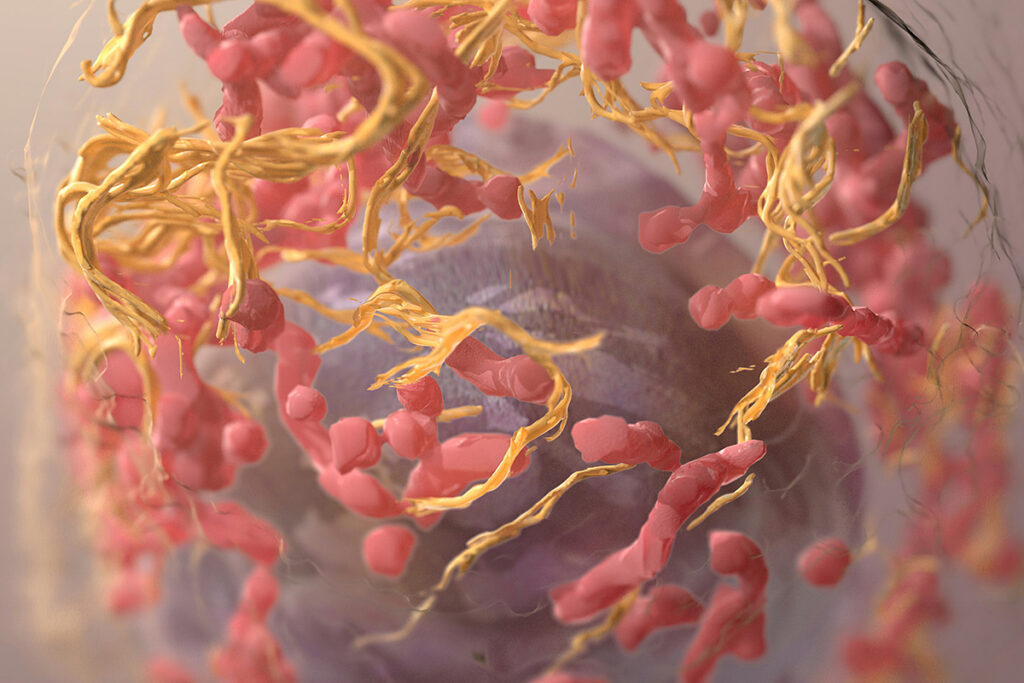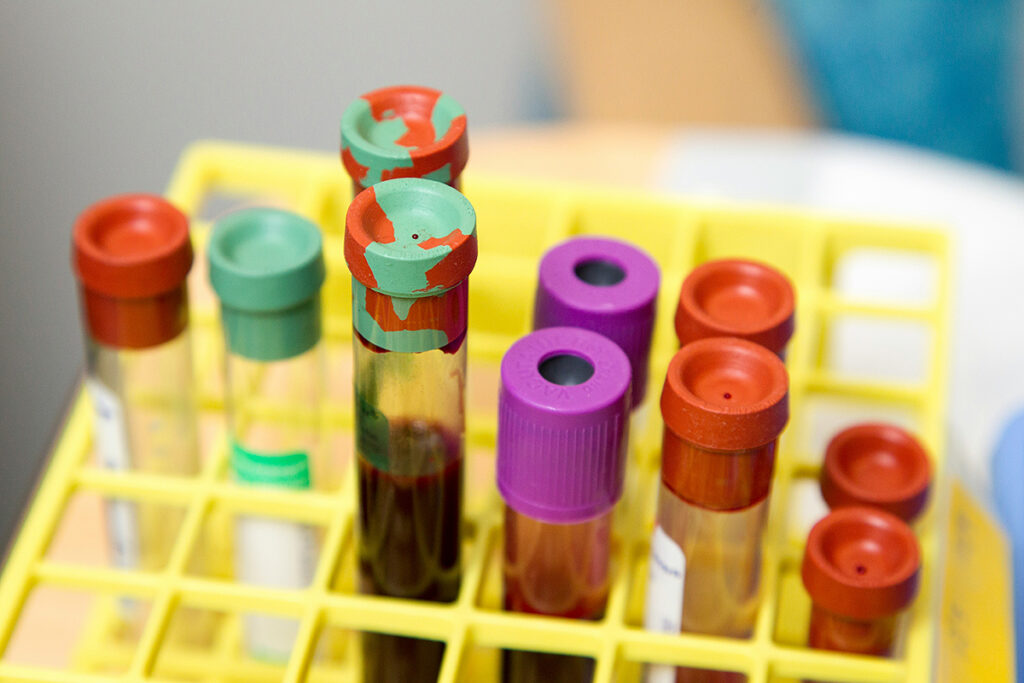Collagen is a protein that plays a vital role in the aging process by maintaining the structure and function of the body’s tissues. In the human body, collagen is found in bones, tendons, ligaments, hair, skin, and muscles. Diet collagen is a source of amino acids. In addition, collagen peptides can influence the extracellular matrix, which provides structural and biochemical support to cells.
Dietary collagen is obtained from the bones, cartilage, tendons, and skin of cattle, pigs, chickens, fish, or other marine organisms. To obtain biologically active peptides, collagen is hydrolyzed. Hydrolyzed collagen is better absorbed and more efficiently used by the body than native collagen.
Hydrolyzed collagen peptides may differ in amino acid composition, solubility, and functionality, depending on the hydrolysis method. The molecular mass of collagen peptides can vary from 0.3 to 8 kDa. Low molecular weight peptides (low mass) have better biological activity than high molecular weight peptides.
The effect of taking collagen peptides is best seen in people with deteriorating collagen characteristics: patients with excess weight, hormonal imbalances, and injuries, as well as during aging and as a result of excessive exercise – these conditions increase the risk of destruction of bone and cartilage tissue.
Collagen Types
Collagen types I, II, and III comprise 80-90% of the total collagen in the human body.
- Type I collagen is most abundant in the skin (80%). Another 15% is type III collagen.
- Type II collagen predominates in cartilage and forms the extracellular matrix (90-95%).
- Other types of collagen (I, IV, V, VI, IX, and XI) help form and stabilize type II collagen fibers.
How Collagen is Digested and Absorbed
Like all proteins in food, collagen is exposed to enzymes during digestion and releases amino acids and peptides, which are absorbed in the small intestine. Collagen contains enzyme-resistant amino acids proline and hydroxyproline, responsible for forming bioactive peptides.
It was believed that only amino acids and di- and tripeptides – molecules containing two and three amino acid residues, respectively, are absorbed in the intestine. However, a 2020 study showed that oligopeptides, molecules containing up to 20 amino acid residues, can also be absorbed. Several studies have shown that the peptides can be absorbed and that plasma levels of proline-hydroxyproline dipeptide (Pro-Hyp) and glycyl-proline-hydroxyproline tripeptide (Gly-Pro-Hyp) are increased following ingestion of hydrolyzed collagen, as well as Pro-Hyp in the skin.
The maximum concentration of collagen peptides in the blood is observed 2 hours after taking hydrolyzed collagen. The concentration is halved after 4 hours.
Hydrolyzed Collagen Helps Fight Skin Aging
Collagen, elastin, and hyaluronic acid are the main components of the skin that support its structure and hydration. Collagen is responsible for the strength and elasticity of the skin and makes up 70-80% of the dermis.
Aging causes structural and functional changes, thinning the skin and reducing its protective barrier function. The aging process, damage, and loss of skin function are facilitated by:
- solar and ultraviolet radiation;
- air pollution;
- tobacco smoke;
- poor nutrition;
- use of cosmetics;
- genetic factors.
FIg. 1. The structure of young, healthy skin and the effect of aging on its design.
Image source: https://www.cell.com/heliyon/fulltext/S2405-8440(23)02168-0
A sign of chronologically aged and photoaged skin changes in the structure of type I collagen, the most common structural protein in the skin. Aging leads to a decrease in the number of collagen bundles in the skin and their synthesis. These changes contribute to a reduction in skin strength and elasticity, increased fragility and dryness of the skin, and, as a result, the formation of wrinkles. Aging can also slow wound healing, improve skin pigmentation, promote the appearance of spider veins, and impair skin immunity.
Mechanisms of hydrolyzed collagen in the dermis:
- Provides amino acids for the synthesis of collagen and elastin fibers;
- Stimulates the production of new collagen, elastin, and hyaluronic acid with the help of biologically active peptides that bind to membrane receptors of fibroblasts – cells that produce collagen in the skin.
Effects of taking hydrolyzed collagen:
- Collagen reduces photoaging and improves collagen fiber organization.
- In women 45-60, taking 10 g of collagen for 12 weeks increased the skin’s elasticity, hydration, radiance, and firmness and reduced wrinkles.
- In women aged 35-50, collagen reduced skin roughness.
- In women 40-60, taking low molecular weight collagen peptide for 12 weeks reduced wrinkles around the eyes.
- Consumption of hydrolyzed collagen increases dermal collagen density, improves wound healing, and protects skin from aging.
- Consumption of native and hydrolyzed collagen improves clinical skin health by increasing extracellular matrix synthesis or suppressing the immune response against endogenous collagen. Collagen and its fragments can stimulate regulatory T cells, which help macrophages acquire wound-healing properties.
- 60-90 days of collagen intake increased skin elasticity and density and reduced expression lines.
In all studies, collagen supplementation was continued for 8-12 weeks at a 1-10 g/day dosage. How long the effect of taking collagen lasts is unknown. It is also unknown how the constant intake of collagen affects the body.
Consuming hydrolyzed collagen can minimize skin aging. However, collagen, like other nutritional supplements, is an adjuvant in treatment despite the beneficial effects. Therefore, given all the internal and external factors contributing to aging, lifestyle, and environmental changes are essential to prevent and treat age-related skin changes.
Hydrolyzed Collagen for The Treatment of Orthopedic Diseases
Loss of collagen in osteoarticular tissues can be associated with aging, hormonal profiles, obesity, inflammation, physical inactivity, mechanical overload, and joint damage. If you lose collagen, your health may benefit from exercise. However, activity can come with repetitive common overuse and injury, contributing to collagen loss.
Osteoarthritis is the most common joint disease, characterized by slow and gradual cartilage degradation and narrowing of the communal space. Osteoarthritis can develop over decades. The main symptoms are pain and progressive loss of joint function. Joint damage leads to microlesions in the connective tissue and reduces the ability of fibroblasts to synthesize new tissue, impairing the structure and function of the extracellular matrix, causing inflammation, and developing into irreversible loss of joint function.
Although collagen is poor in essential amino acids, it may benefit cartilage tissue repair because its amino acid composition is equivalent to connective tissue.
Cartilage is composed primarily of an extracellular matrix, a network of proteins, including type II collagen, that interact with polysaccharides such as hyaluronic acid and chondroitin sulfate, all synthesized and secreted by chondrocytes. In healthy joints, the rate of extracellular matrix production is balanced by the rate of its degradation, ensuring regular cartilage repair.
Collagen type II C-telopeptide (CTX-II) is one of the main biomarkers of cartilage degradation. CTX-II levels are elevated in patients with joint disease, strenuous exercise, postmenopausal women, and overweight and obese individuals.
Effects of taking hydrolyzed collagen:
- In postmenopausal women, two weeks of 0.5 g hydrolyzed collagen plus exercise significantly reduced CTX-II levels, inflammation, joint pain, and stiffness. However, levels of bone resorption biomarkers CTX-I and B-CTX remained unchanged.
- In a study on mice with osteoarthritis, collagen supplementation increased the number of chondrocytes, reducing their death.
- A study in healthy, active 30-year-olds found that taking 3 g/day of hydrolyzed collagen for six weeks improved muscle recovery after exercise.
- Most clinical studies show a significant reduction in pain compared to placebo/control groups and improved stability, mobility, and joint recovery.
- In a study of healthy, active 30-year-olds, collagen promoted increased pain while decreasing circulating markers of injury. Pain perception could be enhanced by pro-inflammatory cytokines, the levels of which increased after exercise. Pain after training was followed by accelerated recovery and adaptation.
- Several studies have shown that taking type II collagen significantly reduces osteoarthritis (WOMAC index), substantially increases physical performance, and reduces stiffness. However, one study showed no significant changes in functional tests.
- Consumption of collagen positively affects the entire bone and joint structure. Collagen peptides improve bone strength and mineral density so that they may benefit osteoporosis.
- Collagen helps increase bone mass and increase cartilage volume.
- Consuming collagen during the growth phase can help bone formation.
- Collagen peptides combined with resistance training increase muscle mass, strength, and motor control.
Hydrolyzed collagen’s effects depend on the collagen’s concentration and characteristics. 2-20 g/day of hydrolyzed collagen stimulates an anabolic response in osteoarticular tissues that resists cartilage wear, reduces extracellular matrix degradation, and may reduce inflammation and pain.
Conclusion
Collagen loss can be influenced by genetics, diet, sun exposure, air pollution, physical inactivity, and excessive physical activity. Loss of collagen in osteoarticular tissues and skin is associated with aging, hormonal profiles, obesity, inflammation, and joint damage.
Collagen supplements may help treat age-related skin changes. Hydrolyzed collagen reduces wrinkles, increases skin elasticity, hydration, firmness, and radiance, makes pores less noticeable, reduces photoaging, increases dermal collagen density, and promotes collagen synthesis in the skin.
In treating orthopedic diseases, collagen increases bone strength, density, and mineral mass, reduces extracellular matrix degradation, suppresses inflammatory cytokines, improves joint stability and mobility, accelerates muscle recovery, reduces pain, and reduces markers of articular cartilage degradation.
Useful article, necessary information? Share it!
Someone will also find it useful and necessary:
Reference
Collagen supplementation in skin and orthopedic diseases: A review of the literature




